MSc Supply Chain Core Concepts: Servitisation and Global Optimisation
VerifiedAdded on 2022/12/29
|10
|3107
|77
Report
AI Summary
This report examines the concept of servitisation and its profound effects on global supply chain optimisation. It begins by defining servitisation as the integration of services with products, leading to increased complexity but also opportunities for value creation. The report then explores how ser...

Coursework
Paraphrase This Document
Need a fresh take? Get an instant paraphrase of this document with our AI Paraphraser
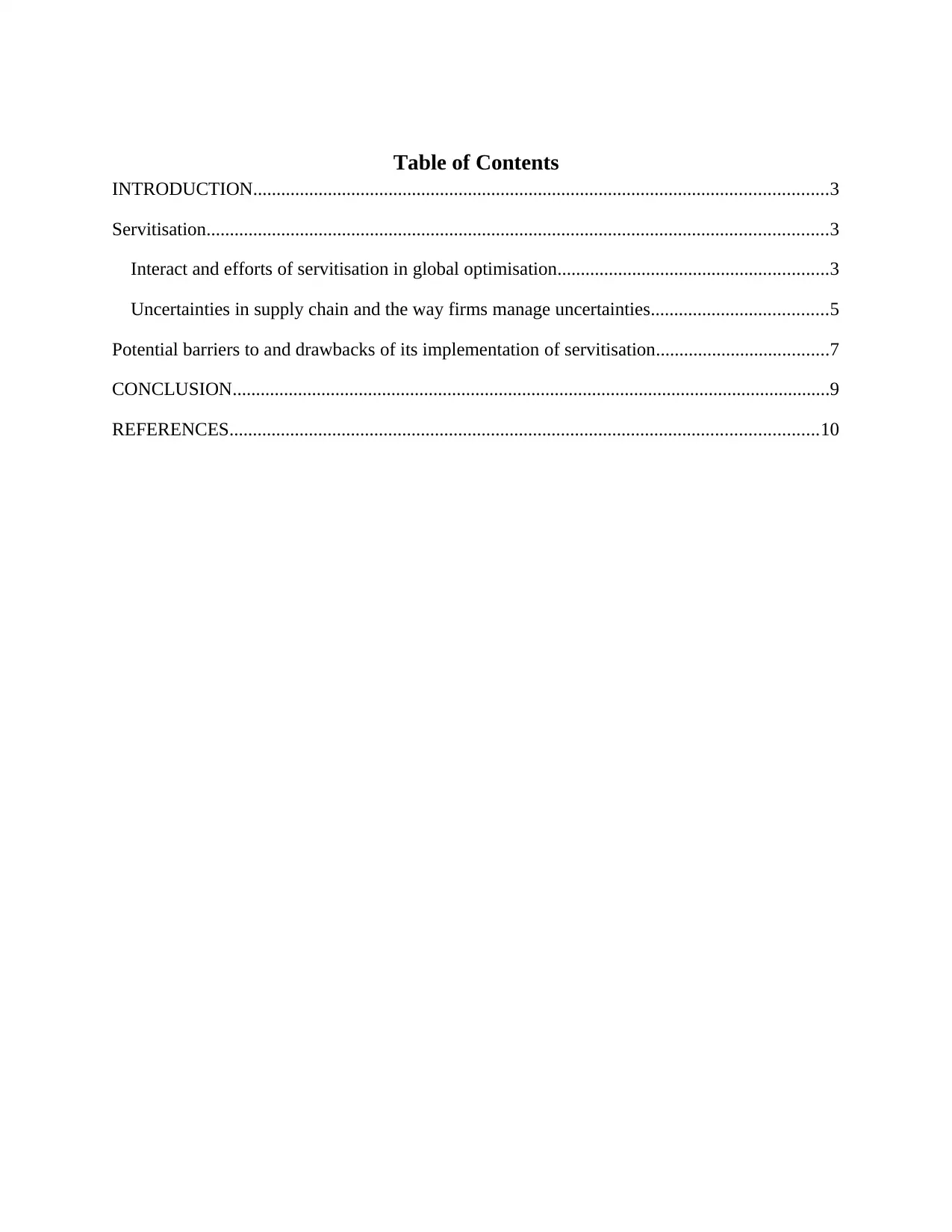
Table of Contents
INTRODUCTION...........................................................................................................................3
Servitisation.....................................................................................................................................3
Interact and efforts of servitisation in global optimisation..........................................................3
Uncertainties in supply chain and the way firms manage uncertainties......................................5
Potential barriers to and drawbacks of its implementation of servitisation.....................................7
CONCLUSION................................................................................................................................9
REFERENCES..............................................................................................................................10
INTRODUCTION...........................................................................................................................3
Servitisation.....................................................................................................................................3
Interact and efforts of servitisation in global optimisation..........................................................3
Uncertainties in supply chain and the way firms manage uncertainties......................................5
Potential barriers to and drawbacks of its implementation of servitisation.....................................7
CONCLUSION................................................................................................................................9
REFERENCES..............................................................................................................................10
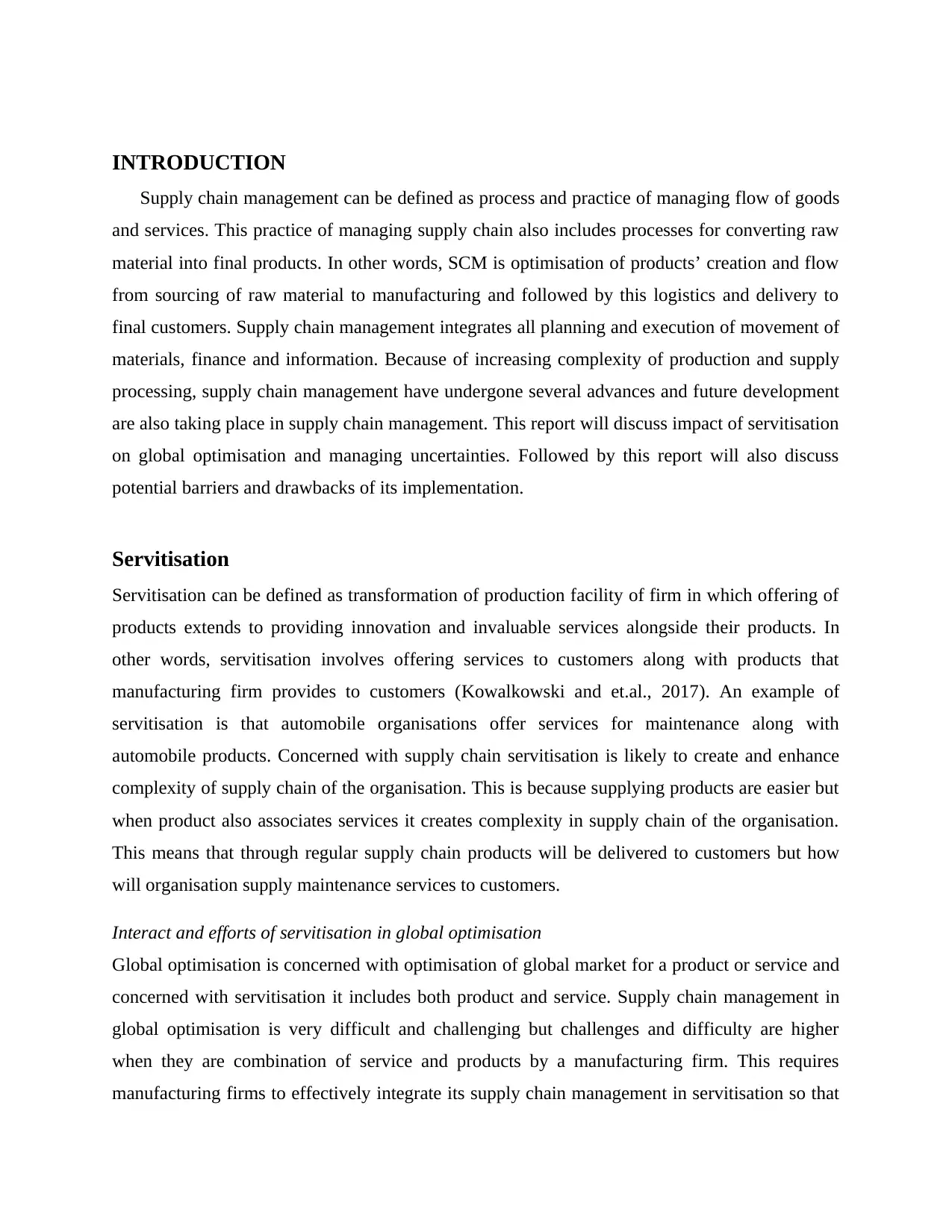
INTRODUCTION
Supply chain management can be defined as process and practice of managing flow of goods
and services. This practice of managing supply chain also includes processes for converting raw
material into final products. In other words, SCM is optimisation of products’ creation and flow
from sourcing of raw material to manufacturing and followed by this logistics and delivery to
final customers. Supply chain management integrates all planning and execution of movement of
materials, finance and information. Because of increasing complexity of production and supply
processing, supply chain management have undergone several advances and future development
are also taking place in supply chain management. This report will discuss impact of servitisation
on global optimisation and managing uncertainties. Followed by this report will also discuss
potential barriers and drawbacks of its implementation.
Servitisation
Servitisation can be defined as transformation of production facility of firm in which offering of
products extends to providing innovation and invaluable services alongside their products. In
other words, servitisation involves offering services to customers along with products that
manufacturing firm provides to customers (Kowalkowski and et.al., 2017). An example of
servitisation is that automobile organisations offer services for maintenance along with
automobile products. Concerned with supply chain servitisation is likely to create and enhance
complexity of supply chain of the organisation. This is because supplying products are easier but
when product also associates services it creates complexity in supply chain of the organisation.
This means that through regular supply chain products will be delivered to customers but how
will organisation supply maintenance services to customers.
Interact and efforts of servitisation in global optimisation
Global optimisation is concerned with optimisation of global market for a product or service and
concerned with servitisation it includes both product and service. Supply chain management in
global optimisation is very difficult and challenging but challenges and difficulty are higher
when they are combination of service and products by a manufacturing firm. This requires
manufacturing firms to effectively integrate its supply chain management in servitisation so that
Supply chain management can be defined as process and practice of managing flow of goods
and services. This practice of managing supply chain also includes processes for converting raw
material into final products. In other words, SCM is optimisation of products’ creation and flow
from sourcing of raw material to manufacturing and followed by this logistics and delivery to
final customers. Supply chain management integrates all planning and execution of movement of
materials, finance and information. Because of increasing complexity of production and supply
processing, supply chain management have undergone several advances and future development
are also taking place in supply chain management. This report will discuss impact of servitisation
on global optimisation and managing uncertainties. Followed by this report will also discuss
potential barriers and drawbacks of its implementation.
Servitisation
Servitisation can be defined as transformation of production facility of firm in which offering of
products extends to providing innovation and invaluable services alongside their products. In
other words, servitisation involves offering services to customers along with products that
manufacturing firm provides to customers (Kowalkowski and et.al., 2017). An example of
servitisation is that automobile organisations offer services for maintenance along with
automobile products. Concerned with supply chain servitisation is likely to create and enhance
complexity of supply chain of the organisation. This is because supplying products are easier but
when product also associates services it creates complexity in supply chain of the organisation.
This means that through regular supply chain products will be delivered to customers but how
will organisation supply maintenance services to customers.
Interact and efforts of servitisation in global optimisation
Global optimisation is concerned with optimisation of global market for a product or service and
concerned with servitisation it includes both product and service. Supply chain management in
global optimisation is very difficult and challenging but challenges and difficulty are higher
when they are combination of service and products by a manufacturing firm. This requires
manufacturing firms to effectively integrate its supply chain management in servitisation so that
⊘ This is a preview!⊘
Do you want full access?
Subscribe today to unlock all pages.

Trusted by 1+ million students worldwide
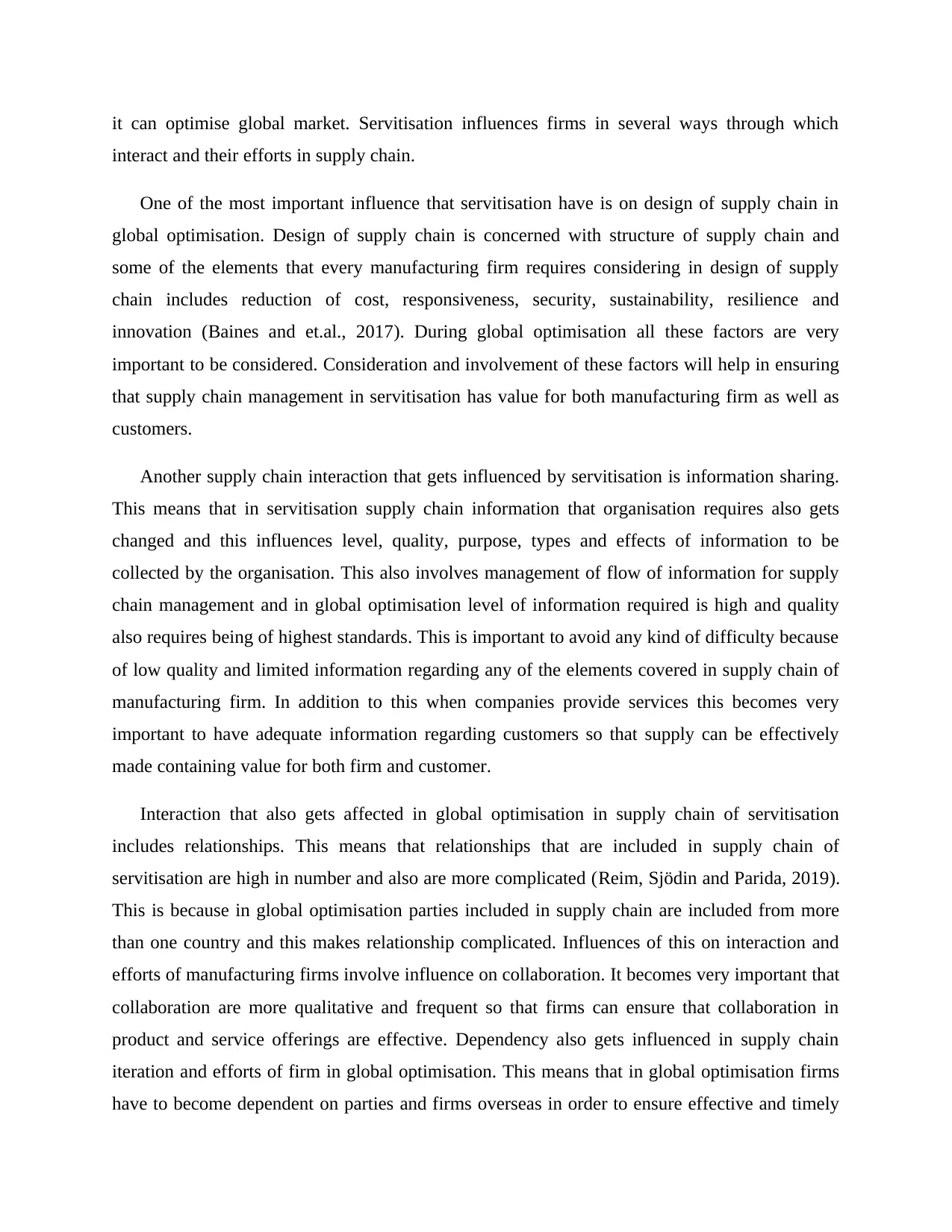
it can optimise global market. Servitisation influences firms in several ways through which
interact and their efforts in supply chain.
One of the most important influence that servitisation have is on design of supply chain in
global optimisation. Design of supply chain is concerned with structure of supply chain and
some of the elements that every manufacturing firm requires considering in design of supply
chain includes reduction of cost, responsiveness, security, sustainability, resilience and
innovation (Baines and et.al., 2017). During global optimisation all these factors are very
important to be considered. Consideration and involvement of these factors will help in ensuring
that supply chain management in servitisation has value for both manufacturing firm as well as
customers.
Another supply chain interaction that gets influenced by servitisation is information sharing.
This means that in servitisation supply chain information that organisation requires also gets
changed and this influences level, quality, purpose, types and effects of information to be
collected by the organisation. This also involves management of flow of information for supply
chain management and in global optimisation level of information required is high and quality
also requires being of highest standards. This is important to avoid any kind of difficulty because
of low quality and limited information regarding any of the elements covered in supply chain of
manufacturing firm. In addition to this when companies provide services this becomes very
important to have adequate information regarding customers so that supply can be effectively
made containing value for both firm and customer.
Interaction that also gets affected in global optimisation in supply chain of servitisation
includes relationships. This means that relationships that are included in supply chain of
servitisation are high in number and also are more complicated (Reim, Sjödin and Parida, 2019).
This is because in global optimisation parties included in supply chain are included from more
than one country and this makes relationship complicated. Influences of this on interaction and
efforts of manufacturing firms involve influence on collaboration. It becomes very important that
collaboration are more qualitative and frequent so that firms can ensure that collaboration in
product and service offerings are effective. Dependency also gets influenced in supply chain
iteration and efforts of firm in global optimisation. This means that in global optimisation firms
have to become dependent on parties and firms overseas in order to ensure effective and timely
interact and their efforts in supply chain.
One of the most important influence that servitisation have is on design of supply chain in
global optimisation. Design of supply chain is concerned with structure of supply chain and
some of the elements that every manufacturing firm requires considering in design of supply
chain includes reduction of cost, responsiveness, security, sustainability, resilience and
innovation (Baines and et.al., 2017). During global optimisation all these factors are very
important to be considered. Consideration and involvement of these factors will help in ensuring
that supply chain management in servitisation has value for both manufacturing firm as well as
customers.
Another supply chain interaction that gets influenced by servitisation is information sharing.
This means that in servitisation supply chain information that organisation requires also gets
changed and this influences level, quality, purpose, types and effects of information to be
collected by the organisation. This also involves management of flow of information for supply
chain management and in global optimisation level of information required is high and quality
also requires being of highest standards. This is important to avoid any kind of difficulty because
of low quality and limited information regarding any of the elements covered in supply chain of
manufacturing firm. In addition to this when companies provide services this becomes very
important to have adequate information regarding customers so that supply can be effectively
made containing value for both firm and customer.
Interaction that also gets affected in global optimisation in supply chain of servitisation
includes relationships. This means that relationships that are included in supply chain of
servitisation are high in number and also are more complicated (Reim, Sjödin and Parida, 2019).
This is because in global optimisation parties included in supply chain are included from more
than one country and this makes relationship complicated. Influences of this on interaction and
efforts of manufacturing firms involve influence on collaboration. It becomes very important that
collaboration are more qualitative and frequent so that firms can ensure that collaboration in
product and service offerings are effective. Dependency also gets influenced in supply chain
iteration and efforts of firm in global optimisation. This means that in global optimisation firms
have to become dependent on parties and firms overseas in order to ensure effective and timely
Paraphrase This Document
Need a fresh take? Get an instant paraphrase of this document with our AI Paraphraser
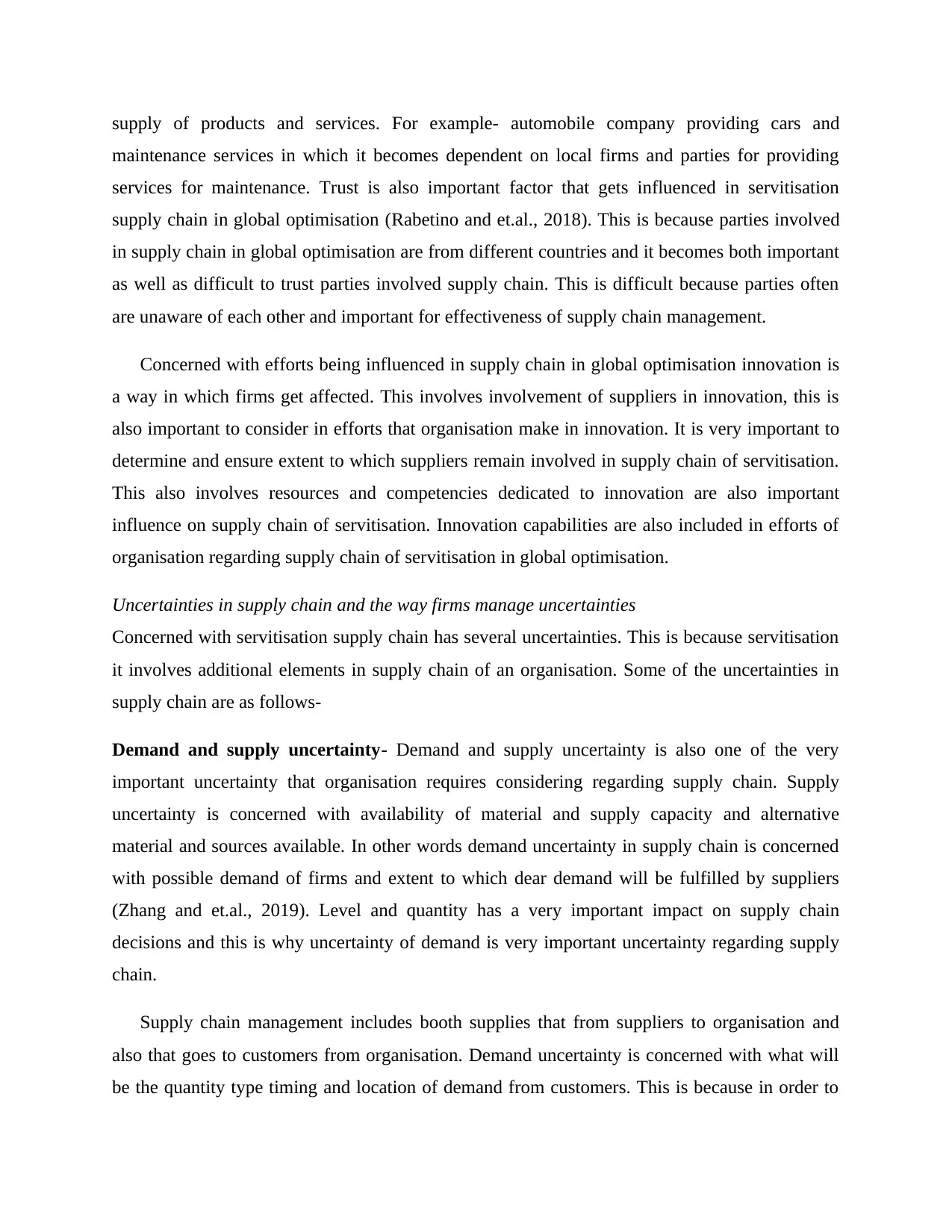
supply of products and services. For example- automobile company providing cars and
maintenance services in which it becomes dependent on local firms and parties for providing
services for maintenance. Trust is also important factor that gets influenced in servitisation
supply chain in global optimisation (Rabetino and et.al., 2018). This is because parties involved
in supply chain in global optimisation are from different countries and it becomes both important
as well as difficult to trust parties involved supply chain. This is difficult because parties often
are unaware of each other and important for effectiveness of supply chain management.
Concerned with efforts being influenced in supply chain in global optimisation innovation is
a way in which firms get affected. This involves involvement of suppliers in innovation, this is
also important to consider in efforts that organisation make in innovation. It is very important to
determine and ensure extent to which suppliers remain involved in supply chain of servitisation.
This also involves resources and competencies dedicated to innovation are also important
influence on supply chain of servitisation. Innovation capabilities are also included in efforts of
organisation regarding supply chain of servitisation in global optimisation.
Uncertainties in supply chain and the way firms manage uncertainties
Concerned with servitisation supply chain has several uncertainties. This is because servitisation
it involves additional elements in supply chain of an organisation. Some of the uncertainties in
supply chain are as follows-
Demand and supply uncertainty- Demand and supply uncertainty is also one of the very
important uncertainty that organisation requires considering regarding supply chain. Supply
uncertainty is concerned with availability of material and supply capacity and alternative
material and sources available. In other words demand uncertainty in supply chain is concerned
with possible demand of firms and extent to which dear demand will be fulfilled by suppliers
(Zhang and et.al., 2019). Level and quantity has a very important impact on supply chain
decisions and this is why uncertainty of demand is very important uncertainty regarding supply
chain.
Supply chain management includes booth supplies that from suppliers to organisation and
also that goes to customers from organisation. Demand uncertainty is concerned with what will
be the quantity type timing and location of demand from customers. This is because in order to
maintenance services in which it becomes dependent on local firms and parties for providing
services for maintenance. Trust is also important factor that gets influenced in servitisation
supply chain in global optimisation (Rabetino and et.al., 2018). This is because parties involved
in supply chain in global optimisation are from different countries and it becomes both important
as well as difficult to trust parties involved supply chain. This is difficult because parties often
are unaware of each other and important for effectiveness of supply chain management.
Concerned with efforts being influenced in supply chain in global optimisation innovation is
a way in which firms get affected. This involves involvement of suppliers in innovation, this is
also important to consider in efforts that organisation make in innovation. It is very important to
determine and ensure extent to which suppliers remain involved in supply chain of servitisation.
This also involves resources and competencies dedicated to innovation are also important
influence on supply chain of servitisation. Innovation capabilities are also included in efforts of
organisation regarding supply chain of servitisation in global optimisation.
Uncertainties in supply chain and the way firms manage uncertainties
Concerned with servitisation supply chain has several uncertainties. This is because servitisation
it involves additional elements in supply chain of an organisation. Some of the uncertainties in
supply chain are as follows-
Demand and supply uncertainty- Demand and supply uncertainty is also one of the very
important uncertainty that organisation requires considering regarding supply chain. Supply
uncertainty is concerned with availability of material and supply capacity and alternative
material and sources available. In other words demand uncertainty in supply chain is concerned
with possible demand of firms and extent to which dear demand will be fulfilled by suppliers
(Zhang and et.al., 2019). Level and quantity has a very important impact on supply chain
decisions and this is why uncertainty of demand is very important uncertainty regarding supply
chain.
Supply chain management includes booth supplies that from suppliers to organisation and
also that goes to customers from organisation. Demand uncertainty is concerned with what will
be the quantity type timing and location of demand from customers. This is because in order to
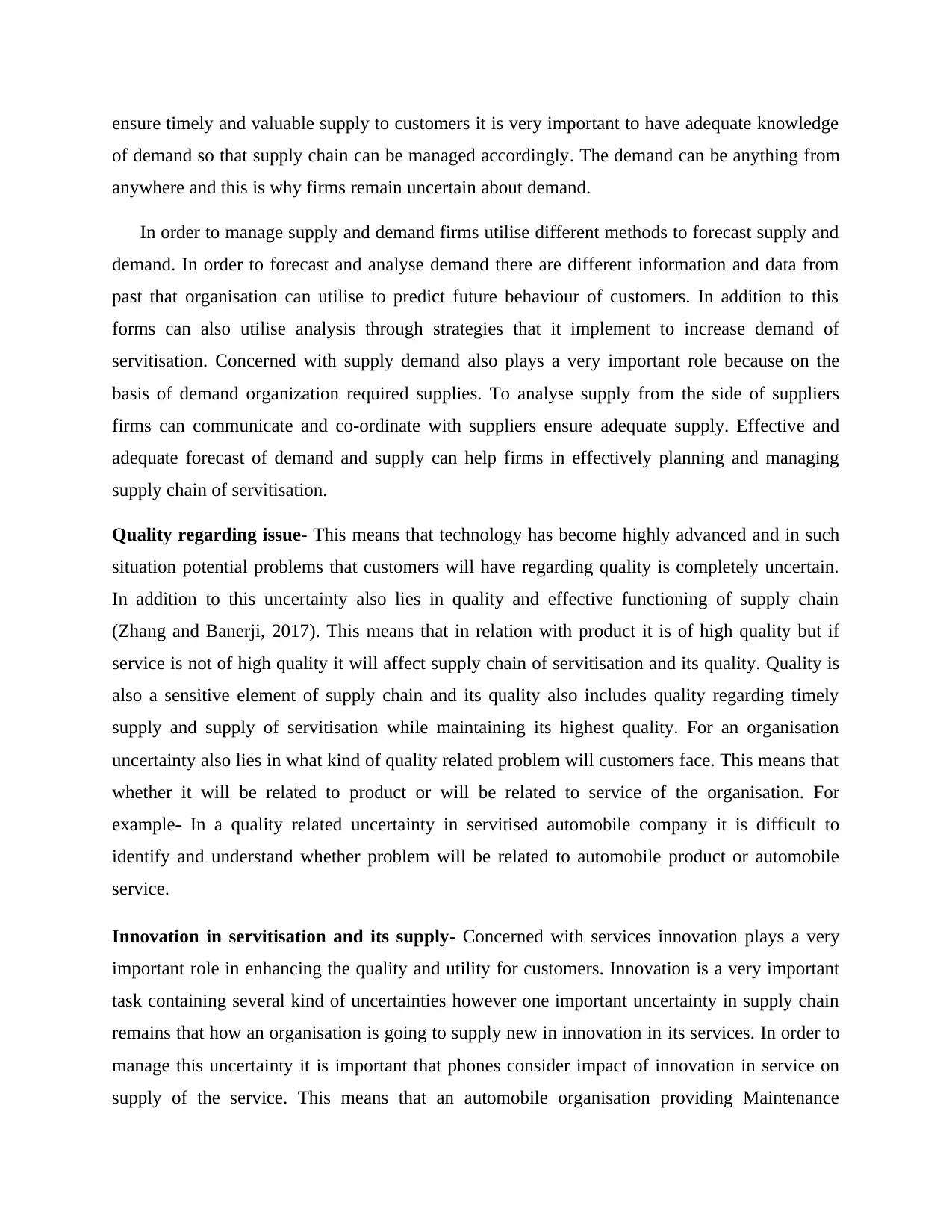
ensure timely and valuable supply to customers it is very important to have adequate knowledge
of demand so that supply chain can be managed accordingly. The demand can be anything from
anywhere and this is why firms remain uncertain about demand.
In order to manage supply and demand firms utilise different methods to forecast supply and
demand. In order to forecast and analyse demand there are different information and data from
past that organisation can utilise to predict future behaviour of customers. In addition to this
forms can also utilise analysis through strategies that it implement to increase demand of
servitisation. Concerned with supply demand also plays a very important role because on the
basis of demand organization required supplies. To analyse supply from the side of suppliers
firms can communicate and co-ordinate with suppliers ensure adequate supply. Effective and
adequate forecast of demand and supply can help firms in effectively planning and managing
supply chain of servitisation.
Quality regarding issue- This means that technology has become highly advanced and in such
situation potential problems that customers will have regarding quality is completely uncertain.
In addition to this uncertainty also lies in quality and effective functioning of supply chain
(Zhang and Banerji, 2017). This means that in relation with product it is of high quality but if
service is not of high quality it will affect supply chain of servitisation and its quality. Quality is
also a sensitive element of supply chain and its quality also includes quality regarding timely
supply and supply of servitisation while maintaining its highest quality. For an organisation
uncertainty also lies in what kind of quality related problem will customers face. This means that
whether it will be related to product or will be related to service of the organisation. For
example- In a quality related uncertainty in servitised automobile company it is difficult to
identify and understand whether problem will be related to automobile product or automobile
service.
Innovation in servitisation and its supply- Concerned with services innovation plays a very
important role in enhancing the quality and utility for customers. Innovation is a very important
task containing several kind of uncertainties however one important uncertainty in supply chain
remains that how an organisation is going to supply new in innovation in its services. In order to
manage this uncertainty it is important that phones consider impact of innovation in service on
supply of the service. This means that an automobile organisation providing Maintenance
of demand so that supply chain can be managed accordingly. The demand can be anything from
anywhere and this is why firms remain uncertain about demand.
In order to manage supply and demand firms utilise different methods to forecast supply and
demand. In order to forecast and analyse demand there are different information and data from
past that organisation can utilise to predict future behaviour of customers. In addition to this
forms can also utilise analysis through strategies that it implement to increase demand of
servitisation. Concerned with supply demand also plays a very important role because on the
basis of demand organization required supplies. To analyse supply from the side of suppliers
firms can communicate and co-ordinate with suppliers ensure adequate supply. Effective and
adequate forecast of demand and supply can help firms in effectively planning and managing
supply chain of servitisation.
Quality regarding issue- This means that technology has become highly advanced and in such
situation potential problems that customers will have regarding quality is completely uncertain.
In addition to this uncertainty also lies in quality and effective functioning of supply chain
(Zhang and Banerji, 2017). This means that in relation with product it is of high quality but if
service is not of high quality it will affect supply chain of servitisation and its quality. Quality is
also a sensitive element of supply chain and its quality also includes quality regarding timely
supply and supply of servitisation while maintaining its highest quality. For an organisation
uncertainty also lies in what kind of quality related problem will customers face. This means that
whether it will be related to product or will be related to service of the organisation. For
example- In a quality related uncertainty in servitised automobile company it is difficult to
identify and understand whether problem will be related to automobile product or automobile
service.
Innovation in servitisation and its supply- Concerned with services innovation plays a very
important role in enhancing the quality and utility for customers. Innovation is a very important
task containing several kind of uncertainties however one important uncertainty in supply chain
remains that how an organisation is going to supply new in innovation in its services. In order to
manage this uncertainty it is important that phones consider impact of innovation in service on
supply of the service. This means that an automobile organisation providing Maintenance
⊘ This is a preview!⊘
Do you want full access?
Subscribe today to unlock all pages.

Trusted by 1+ million students worldwide
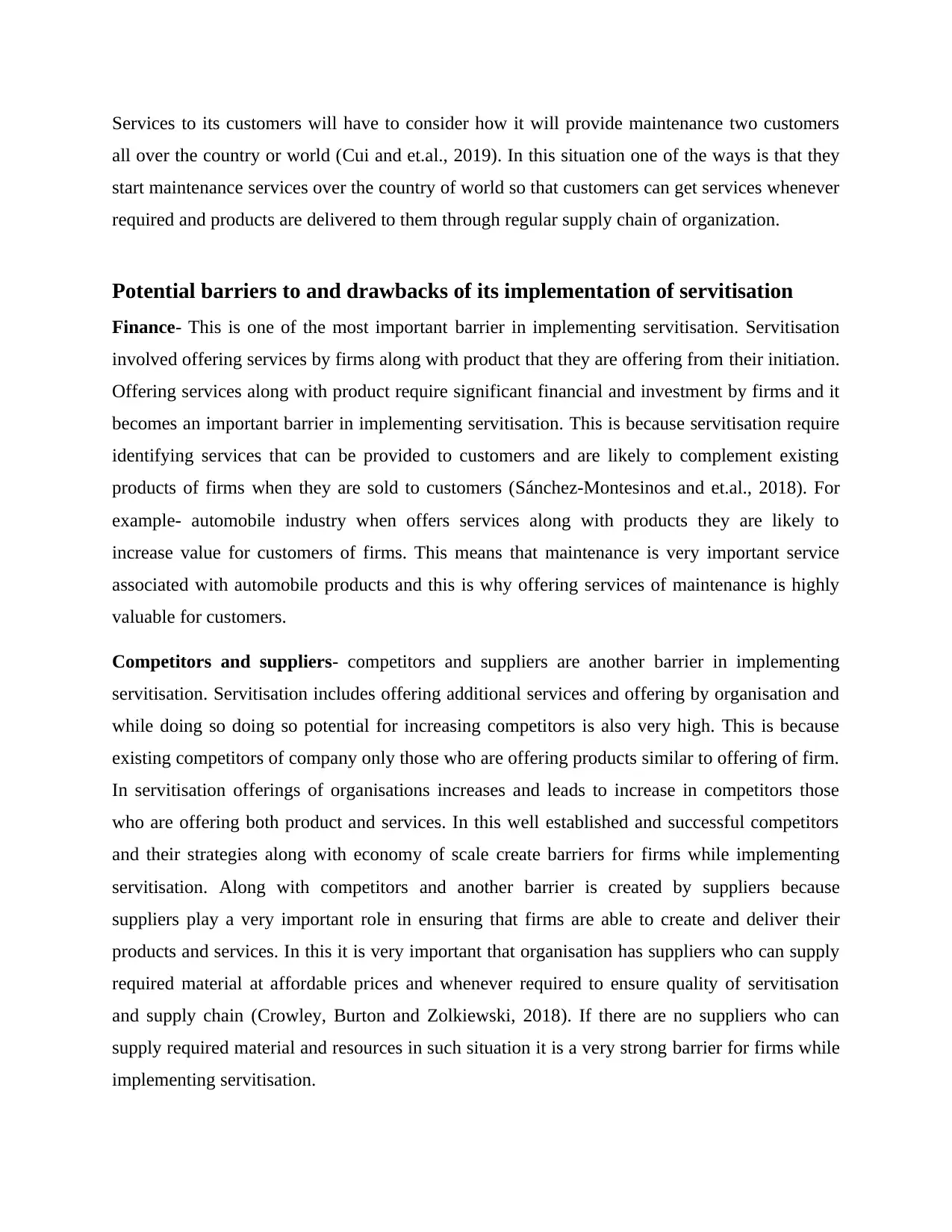
Services to its customers will have to consider how it will provide maintenance two customers
all over the country or world (Cui and et.al., 2019). In this situation one of the ways is that they
start maintenance services over the country of world so that customers can get services whenever
required and products are delivered to them through regular supply chain of organization.
Potential barriers to and drawbacks of its implementation of servitisation
Finance- This is one of the most important barrier in implementing servitisation. Servitisation
involved offering services by firms along with product that they are offering from their initiation.
Offering services along with product require significant financial and investment by firms and it
becomes an important barrier in implementing servitisation. This is because servitisation require
identifying services that can be provided to customers and are likely to complement existing
products of firms when they are sold to customers (Sánchez‐Montesinos and et.al., 2018). For
example- automobile industry when offers services along with products they are likely to
increase value for customers of firms. This means that maintenance is very important service
associated with automobile products and this is why offering services of maintenance is highly
valuable for customers.
Competitors and suppliers- competitors and suppliers are another barrier in implementing
servitisation. Servitisation includes offering additional services and offering by organisation and
while doing so doing so potential for increasing competitors is also very high. This is because
existing competitors of company only those who are offering products similar to offering of firm.
In servitisation offerings of organisations increases and leads to increase in competitors those
who are offering both product and services. In this well established and successful competitors
and their strategies along with economy of scale create barriers for firms while implementing
servitisation. Along with competitors and another barrier is created by suppliers because
suppliers play a very important role in ensuring that firms are able to create and deliver their
products and services. In this it is very important that organisation has suppliers who can supply
required material at affordable prices and whenever required to ensure quality of servitisation
and supply chain (Crowley, Burton and Zolkiewski, 2018). If there are no suppliers who can
supply required material and resources in such situation it is a very strong barrier for firms while
implementing servitisation.
all over the country or world (Cui and et.al., 2019). In this situation one of the ways is that they
start maintenance services over the country of world so that customers can get services whenever
required and products are delivered to them through regular supply chain of organization.
Potential barriers to and drawbacks of its implementation of servitisation
Finance- This is one of the most important barrier in implementing servitisation. Servitisation
involved offering services by firms along with product that they are offering from their initiation.
Offering services along with product require significant financial and investment by firms and it
becomes an important barrier in implementing servitisation. This is because servitisation require
identifying services that can be provided to customers and are likely to complement existing
products of firms when they are sold to customers (Sánchez‐Montesinos and et.al., 2018). For
example- automobile industry when offers services along with products they are likely to
increase value for customers of firms. This means that maintenance is very important service
associated with automobile products and this is why offering services of maintenance is highly
valuable for customers.
Competitors and suppliers- competitors and suppliers are another barrier in implementing
servitisation. Servitisation includes offering additional services and offering by organisation and
while doing so doing so potential for increasing competitors is also very high. This is because
existing competitors of company only those who are offering products similar to offering of firm.
In servitisation offerings of organisations increases and leads to increase in competitors those
who are offering both product and services. In this well established and successful competitors
and their strategies along with economy of scale create barriers for firms while implementing
servitisation. Along with competitors and another barrier is created by suppliers because
suppliers play a very important role in ensuring that firms are able to create and deliver their
products and services. In this it is very important that organisation has suppliers who can supply
required material at affordable prices and whenever required to ensure quality of servitisation
and supply chain (Crowley, Burton and Zolkiewski, 2018). If there are no suppliers who can
supply required material and resources in such situation it is a very strong barrier for firms while
implementing servitisation.
Paraphrase This Document
Need a fresh take? Get an instant paraphrase of this document with our AI Paraphraser

Knowledge and information- This is another important barrier for implementing servitisation in
firms. Implementation of servitisation required that organisation have adequate knowledge and
information regarding the new processes that they are implementing within organisation.
Information and knowledge play a very important role in success of everything within firms.
This means that forms required right methods for communicating servitisation in organisation in
order to ensure that everyone can participate in servitisation within organisation. Knowledge and
information affect several aspects of implementation of servitisation in supply chain. This
involved knowledge and information regarding requirements of customers’ services being
included in organisational offering and effective knowledge and information regarding impact of
services on supply chain of organisation. Adequate knowledge and information enables effective
performance of organisation however lack of Information and knowledge can create barrier in
implementing servitisation.
Organizational operations- Organisational operations are also important barriers in
implementation of servitisation (Ziaee Bigdeli and et.al., 2018). Organisational operations when
are at large level it creates barrier in implementing servitisation at organisational level. This
mainly includes organisations that are operating on a global level and in such situation
implementing change specifically like servitisation becomes very difficult. This way
organisational operations is an important barrier in implementation of servitisation.
Drawbacks of implementation of servitisation
Transition cost- Transition cost is one of the most important drawback of
servitisation.Transition include offering product along with services and this involve significant
transition in firms and this is why transition cost involved is also significant. Servitization also
include changing existing product offerings of firm in service from product and this is a
transition that includes original product of firm and this is why cost associated with it is also
significant. Transition cost this is why is biggest drawback of servitization.
Switching sales model- Another important drawback of servitization is switching of sales model
of business organisation. This means that when products are offered in form of services in such
situation organisations requires switching there sales model so that they can sale the product
(Kamal and et.al., 2020). This is because ways and forms in which products are sold are different
firms. Implementation of servitisation required that organisation have adequate knowledge and
information regarding the new processes that they are implementing within organisation.
Information and knowledge play a very important role in success of everything within firms.
This means that forms required right methods for communicating servitisation in organisation in
order to ensure that everyone can participate in servitisation within organisation. Knowledge and
information affect several aspects of implementation of servitisation in supply chain. This
involved knowledge and information regarding requirements of customers’ services being
included in organisational offering and effective knowledge and information regarding impact of
services on supply chain of organisation. Adequate knowledge and information enables effective
performance of organisation however lack of Information and knowledge can create barrier in
implementing servitisation.
Organizational operations- Organisational operations are also important barriers in
implementation of servitisation (Ziaee Bigdeli and et.al., 2018). Organisational operations when
are at large level it creates barrier in implementing servitisation at organisational level. This
mainly includes organisations that are operating on a global level and in such situation
implementing change specifically like servitisation becomes very difficult. This way
organisational operations is an important barrier in implementation of servitisation.
Drawbacks of implementation of servitisation
Transition cost- Transition cost is one of the most important drawback of
servitisation.Transition include offering product along with services and this involve significant
transition in firms and this is why transition cost involved is also significant. Servitization also
include changing existing product offerings of firm in service from product and this is a
transition that includes original product of firm and this is why cost associated with it is also
significant. Transition cost this is why is biggest drawback of servitization.
Switching sales model- Another important drawback of servitization is switching of sales model
of business organisation. This means that when products are offered in form of services in such
situation organisations requires switching there sales model so that they can sale the product
(Kamal and et.al., 2020). This is because ways and forms in which products are sold are different

from services and this is why firms required changing their sales model to ensure success of
servitisation.
Loss of core business model- Servitization also course loss of core business model of a firm.
This means that servitisation is an addition in existing business practices and this is why it is
very important that organisation focuses on servitisation in order to ensure its success. However
servitisation may affect existing business and success of existing business of an organisation.
This causes loss of core business of an organisation and also affect attention that organisation
provide to core business.
Complication in business model- This is also one of the drawback of servitisation in
organisation. And organisational already operating with a product later includes service in its
offerings and this creates complications and difficulties in organisational operation and
management (West and et.al., 2018). Servitization also includes significant changes in existing
business practices and this create complication in organization while implementing changes. This
is also a drawback of implementing servitization in organisation as well as in supply chain of
firms.
CONCLUSION
On the basis of above discussion it can be concluded that servitization is transformation
of a production facility in which they start providing services along with or instead of products.
This report discussed about impact of privatization on introduction and efforts of organisation
regarding Global Optimisation and discussion out lines that it has a significant impact on global
optimisation of firms. There are several ways in which organisations get affected by different
elements of supply chain. In addition to this report also discuss about uncertainties in supply
chain and ways in which firms manage uncertainties. Lastly, report discussed potential barriers
and drawbacks for implementing servitization in organisation and regarding this some areas and
drawbacks were discussed in report.
servitisation.
Loss of core business model- Servitization also course loss of core business model of a firm.
This means that servitisation is an addition in existing business practices and this is why it is
very important that organisation focuses on servitisation in order to ensure its success. However
servitisation may affect existing business and success of existing business of an organisation.
This causes loss of core business of an organisation and also affect attention that organisation
provide to core business.
Complication in business model- This is also one of the drawback of servitisation in
organisation. And organisational already operating with a product later includes service in its
offerings and this creates complications and difficulties in organisational operation and
management (West and et.al., 2018). Servitization also includes significant changes in existing
business practices and this create complication in organization while implementing changes. This
is also a drawback of implementing servitization in organisation as well as in supply chain of
firms.
CONCLUSION
On the basis of above discussion it can be concluded that servitization is transformation
of a production facility in which they start providing services along with or instead of products.
This report discussed about impact of privatization on introduction and efforts of organisation
regarding Global Optimisation and discussion out lines that it has a significant impact on global
optimisation of firms. There are several ways in which organisations get affected by different
elements of supply chain. In addition to this report also discuss about uncertainties in supply
chain and ways in which firms manage uncertainties. Lastly, report discussed potential barriers
and drawbacks for implementing servitization in organisation and regarding this some areas and
drawbacks were discussed in report.
⊘ This is a preview!⊘
Do you want full access?
Subscribe today to unlock all pages.

Trusted by 1+ million students worldwide
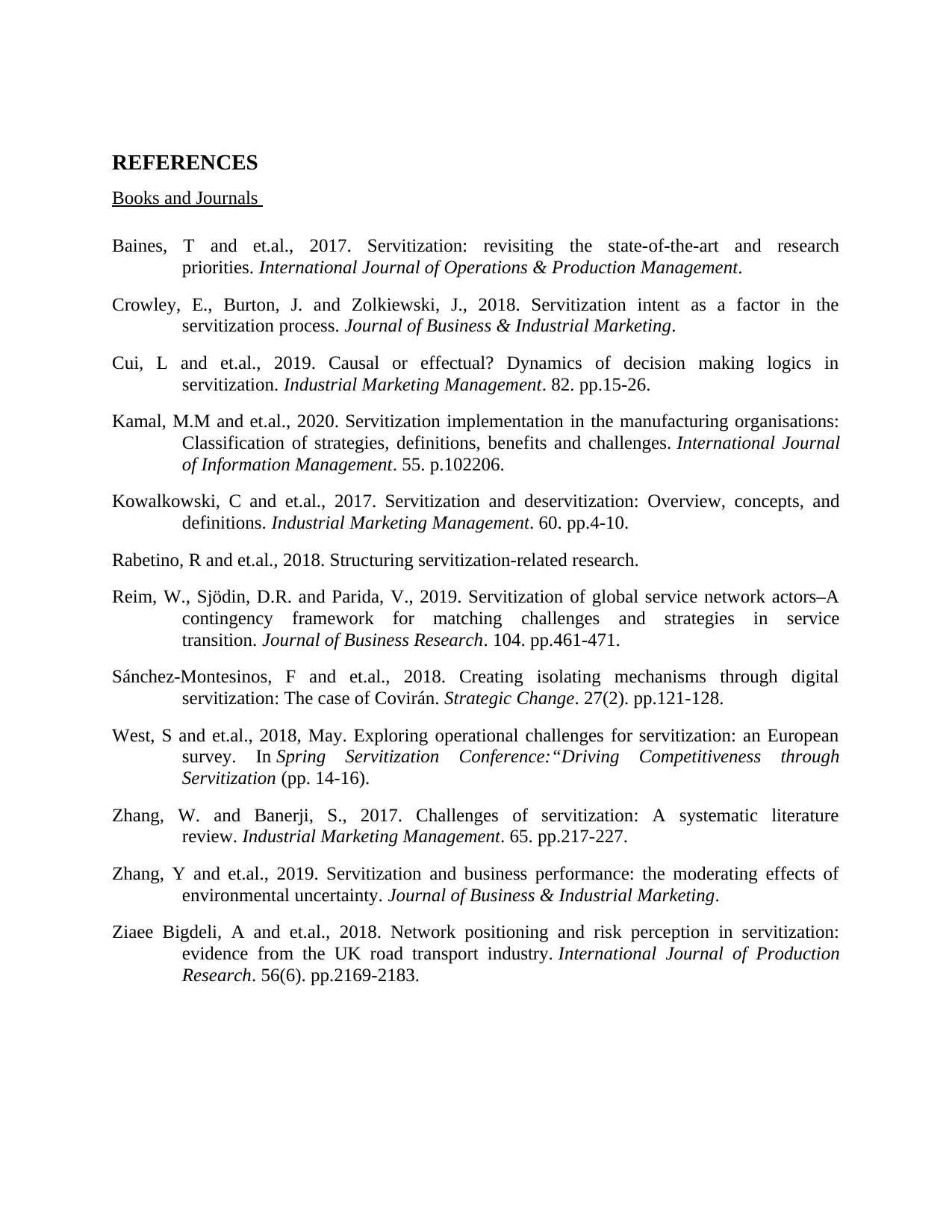
REFERENCES
Books and Journals
Baines, T and et.al., 2017. Servitization: revisiting the state-of-the-art and research
priorities. International Journal of Operations & Production Management.
Crowley, E., Burton, J. and Zolkiewski, J., 2018. Servitization intent as a factor in the
servitization process. Journal of Business & Industrial Marketing.
Cui, L and et.al., 2019. Causal or effectual? Dynamics of decision making logics in
servitization. Industrial Marketing Management. 82. pp.15-26.
Kamal, M.M and et.al., 2020. Servitization implementation in the manufacturing organisations:
Classification of strategies, definitions, benefits and challenges. International Journal
of Information Management. 55. p.102206.
Kowalkowski, C and et.al., 2017. Servitization and deservitization: Overview, concepts, and
definitions. Industrial Marketing Management. 60. pp.4-10.
Rabetino, R and et.al., 2018. Structuring servitization-related research.
Reim, W., Sjödin, D.R. and Parida, V., 2019. Servitization of global service network actors–A
contingency framework for matching challenges and strategies in service
transition. Journal of Business Research. 104. pp.461-471.
Sánchez‐Montesinos, F and et.al., 2018. Creating isolating mechanisms through digital
servitization: The case of Covirán. Strategic Change. 27(2). pp.121-128.
West, S and et.al., 2018, May. Exploring operational challenges for servitization: an European
survey. In Spring Servitization Conference:“Driving Competitiveness through
Servitization (pp. 14-16).
Zhang, W. and Banerji, S., 2017. Challenges of servitization: A systematic literature
review. Industrial Marketing Management. 65. pp.217-227.
Zhang, Y and et.al., 2019. Servitization and business performance: the moderating effects of
environmental uncertainty. Journal of Business & Industrial Marketing.
Ziaee Bigdeli, A and et.al., 2018. Network positioning and risk perception in servitization:
evidence from the UK road transport industry. International Journal of Production
Research. 56(6). pp.2169-2183.
Books and Journals
Baines, T and et.al., 2017. Servitization: revisiting the state-of-the-art and research
priorities. International Journal of Operations & Production Management.
Crowley, E., Burton, J. and Zolkiewski, J., 2018. Servitization intent as a factor in the
servitization process. Journal of Business & Industrial Marketing.
Cui, L and et.al., 2019. Causal or effectual? Dynamics of decision making logics in
servitization. Industrial Marketing Management. 82. pp.15-26.
Kamal, M.M and et.al., 2020. Servitization implementation in the manufacturing organisations:
Classification of strategies, definitions, benefits and challenges. International Journal
of Information Management. 55. p.102206.
Kowalkowski, C and et.al., 2017. Servitization and deservitization: Overview, concepts, and
definitions. Industrial Marketing Management. 60. pp.4-10.
Rabetino, R and et.al., 2018. Structuring servitization-related research.
Reim, W., Sjödin, D.R. and Parida, V., 2019. Servitization of global service network actors–A
contingency framework for matching challenges and strategies in service
transition. Journal of Business Research. 104. pp.461-471.
Sánchez‐Montesinos, F and et.al., 2018. Creating isolating mechanisms through digital
servitization: The case of Covirán. Strategic Change. 27(2). pp.121-128.
West, S and et.al., 2018, May. Exploring operational challenges for servitization: an European
survey. In Spring Servitization Conference:“Driving Competitiveness through
Servitization (pp. 14-16).
Zhang, W. and Banerji, S., 2017. Challenges of servitization: A systematic literature
review. Industrial Marketing Management. 65. pp.217-227.
Zhang, Y and et.al., 2019. Servitization and business performance: the moderating effects of
environmental uncertainty. Journal of Business & Industrial Marketing.
Ziaee Bigdeli, A and et.al., 2018. Network positioning and risk perception in servitization:
evidence from the UK road transport industry. International Journal of Production
Research. 56(6). pp.2169-2183.
1 out of 10
Related Documents
Your All-in-One AI-Powered Toolkit for Academic Success.
+13062052269
info@desklib.com
Available 24*7 on WhatsApp / Email
![[object Object]](/_next/static/media/star-bottom.7253800d.svg)
Unlock your academic potential
© 2024 | Zucol Services PVT LTD | All rights reserved.





